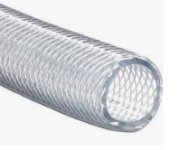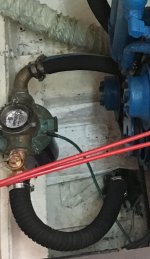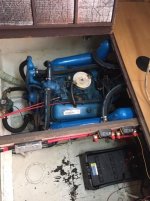I have 454 crusader engines and I've just spent a fortune getting all the crap out of my salt water side of my engine cooling systems (heat exchangers, trans cooler, exhaust elbows) on both engines, that were completely clogged up. So I'm thinking I'll flush out the system each time I return from an outing from now on.
My plan is to put a T into the raw water line going to the trans cooler ( the first component) from the salt water pick up line coming in from the intake on the bottom of the hull. I'll put a ball valve in that raw water hose just before the trans cooler . On the other part of the T fitting, I'll put another ball valve. That ball valve will have fresh water coming in from a new hose I'll install from a fitting on the side of my boat that a garden hose can screw into. From that fitting I'll hook up a garden hose to the freshwater supply on the dock.
When I get back from an outing, I'll hook up a garden hose from the dock freshwater supply to the inlet on my boat that will lead directly to that ball valve I just mentioned. Then I'll shut off the salt water ball valve, turn on the tap on the dock fresh water supply and then open the fresh water valve. Then run the engines for 15 to 30 minutes. That should be enough time for all the salt water to be pushed out of the trans cooler and exhaust elbows and the heat exchanger and it will leave fresh water in all those parts once I turn off the engines, until the next time I head out. Obviously it would be essential to remember to reverse the ball valves direction on both engines before I head out again.
Does all that make sense or am I overlooking anything?
My plan is to put a T into the raw water line going to the trans cooler ( the first component) from the salt water pick up line coming in from the intake on the bottom of the hull. I'll put a ball valve in that raw water hose just before the trans cooler . On the other part of the T fitting, I'll put another ball valve. That ball valve will have fresh water coming in from a new hose I'll install from a fitting on the side of my boat that a garden hose can screw into. From that fitting I'll hook up a garden hose to the freshwater supply on the dock.
When I get back from an outing, I'll hook up a garden hose from the dock freshwater supply to the inlet on my boat that will lead directly to that ball valve I just mentioned. Then I'll shut off the salt water ball valve, turn on the tap on the dock fresh water supply and then open the fresh water valve. Then run the engines for 15 to 30 minutes. That should be enough time for all the salt water to be pushed out of the trans cooler and exhaust elbows and the heat exchanger and it will leave fresh water in all those parts once I turn off the engines, until the next time I head out. Obviously it would be essential to remember to reverse the ball valves direction on both engines before I head out again.
Does all that make sense or am I overlooking anything?




